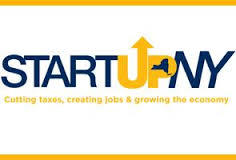
The State University of New York (SUNY)―the largest university in the United States, with nearly 600,000 students located in 64 publicly-funded higher education institutions―has served an important educational function for the people of New York and of the United States. But its recent “partnerships” with private businesses have been far less productive.
In the spring of 2013, New York Governor Andrew Cuomo, joined by businessmen, politicians, and top SUNY administrators, embarked upon a widely-publicized barnstorming campaign to get the state legislature to adopt a plan he called Tax-Free NY. Under its provisions, most of the SUNY campuses, portions of the City University of New York, and zones adjacent to SUNY campuses would be thrown open to private, profit-making companies that would be exempt from state and local taxes on sales, property, the income of their owners, and the income of their employees for a period of ten years.
Tax-Free NY, Cuomo announced, was “a game-changing initiative” that would “transform SUNY campuses and university communities across the state.” According to the governor, this program would “supercharge” the state’s economy and bring job creation to an unprecedented level. Conceding that these tax-free zones wouldn’t work without a dramatic “culture shift” in the SUNY system, Cuomo argued that the faculty should “get interested and participate in entrepreneurial activities.”
Despite criticism of the program by educators, unions, and even some conservatives, SUNY administrators and local officials fell into line. Reluctant to challenge the governor and oppose this widely-touted jobs creation measure, the state legislature established the program, renamed Start-Up NY and including some private colleges, in June 2013.
Start-Up NY quickly acquired considerable momentum. Hundreds of tax-free zones were established at New York colleges and universities, most of them on SUNY campuses, with numerous administrators hired to oversee the development of the new commercial programs. New York State launched a very expensive Start-Up NY television advertising campaign around the nation, with ads focused on the theme: “New York: Open for Business.” SUNY’s chancellor, Nancy Zimpher, proclaimed: “Nowhere in the country do new businesses . . . stand to benefit more by partnering with higher education than in New York State, thanks to the widespread success of Governor Cuomo’s Start-Up NY program. With interest and investment coming in from around the globe and new jobs being created in every region, Start-Up NY has provided a spark for our economy and for SUNY.” This was, she declared, a “transformative initiative.”
Although no one seems to know―or at least has revealed―just how much Start-Up NY has actually cost New York State, it has certainly been quite expensive. Back in 2013, the governor’s budget office estimated that it would cost $323 million over the next three years. That figure did not include the lost tax revenue to localities.
And what has it produced for the state? After three years of operation―2014, 2015, and 2016―that question is answered by the official reports of Empire State Development (New York’s official economic development agency). In 2014, Start-Up NY produced 76 jobs. In 2015, it produced 332 jobs. And, in 2016, it produced 757 jobs. Deducting 30 jobs apparently lost somewhere along the way, Empire State Development claimed a grand total of 1,135 jobs were developed by Start-Up NY.
Although 1,135 jobs might strike the observer as a remarkably small increase in the state’s total workforce of over 9 million people, it’s actually an inflated figure. According to Empire State Development, only 722 of these jobs could be considered “net new jobs.” Many of the participating companies did not really create new jobs at all, but simply moved their operations to another region of the state to avail themselves of Start-Up NY’s tax breaks.
Moreover, it’s far from clear that Start-Up NY’s tax breaks were necessary for businesses to hire these 722 workers. After all, 2014, 2015, and 2016 were years of recovery from the Great Recession, during which employment in New York State grew by 168,401 jobs.
What about the benefit of the program to SUNY? According to the SUNY administration, at the beginning of 2017, half of all SUNY schools had become sponsors of Start-Up NY businesses, with 201 campus “partnerships.” Although Chancellor Zimpher has spoken enthusiastically about the program’s “academic benefits for our faculty and students,” her examples are less than convincing. Yes, the participating companies paid SUNY a modest rental for their use of campus facilities. But this business use deprived SUNY faculty and students of their ability to avail themselves of these same facilities―including buildings, classroom space, labs, and advanced machinery and equipment. The chancellor also pointed to 134 students who had interned at Start-Up businesses and 121 who had gone to work for Start-Up firms. But these figures are not impressive when set against SUNY’s student enrollment of nearly 600,000.
Perhaps most significant, what is the academic merit of devoting university teaching or education to producing or marketing corporate projects? Shouldn’t the role of higher education be the advancement and diffusion of knowledge?
Of course, creating jobs is a laudable goal. But using public funds and facilities to subsidize private, profit-making businesses is not the only way to do it. For example, state governments could simply hire teachers, firefighters, construction workers, home health aides, social workers, health and safety inspectors, and thousands of other workers to do work that need to be done.
Overall, several questions arise from this history of SUNY-corporate collaboration. Does this “partnership” produce enough economic benefit to be worth the cost? Is assisting private business research, development, and sales an appropriate role for higher education? Finally, is using public funds to subsidize profit-making corporations an appropriate role for government? These questions are certainly worth considering before states rush into promoting further ill-fated university-corporate “partnerships.”
Lawrence Wittner (http://www.lawrenceswittner.com) is Professor of History emeritus at SUNY/Albany. His latest book is a satirical novel about university corporatization and rebellion, What’s Going On at UAardvark?
